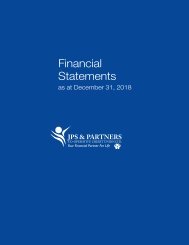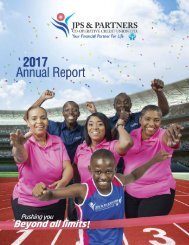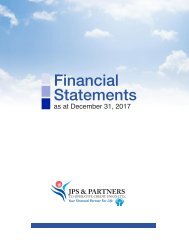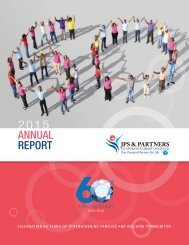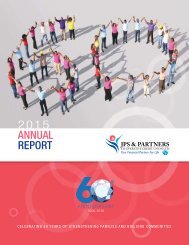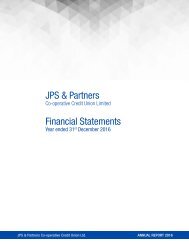JPS & Partners - Financial Statements 31st December2018 (4.4.19)
Create successful ePaper yourself
Turn your PDF publications into a flip-book with our unique Google optimized e-Paper software.
<strong>JPS</strong> & PARTNERS CO-OPERATIVE CREDIT UNION LIMITED<br />
NOTES TO THE FINANCIAL STATEMENTS - CONT'D<br />
FOR THE YEAR ENDED 31ST DECEMBER 2018<br />
(Expressed in Jamaican Dollars unless otherwise indicated)<br />
Page 16<br />
3. Statement of Compliance, Basis of Preparation and Significant Accounting Policies (cont'd):<br />
(e) <strong>Financial</strong> Investments-<br />
At initial recognition, the Credit Union measures a financial asset at its fair value, plus or minus (in the case of a<br />
financial asset not at fair value through profit or loss transaction costs that are incremental and directly attributable to<br />
the acquisition or issue of the financial asset; such as fees and commissions. Transaction costs of financial assets<br />
carried at fair value through profit or loss are expensed in profit or loss.<br />
Immediately after recognition, an expected credit loss allowance (ECL) is recognised for financial assets measured at<br />
amortised cost and investments in debt instruments measured at FVOCI, which results in an accounting loss being<br />
recognised in profit or loss when an asset is newly originated.<br />
From 1st January 2018, the Credit Union has applied IFRS 9 and classified its financial assets as either Fair value<br />
through profit or loss (FVTPL); Fair value through other comprehensive income (FVOCI) or Amortised cost.<br />
Classification and subsequent measurement of debt instruments depend on the credit union's business model for<br />
managing the asset; and the cash flow characteristics of the asset.<br />
Based on these factors, the credit union classifies its debt instruments into one of the following three measurement<br />
categories:<br />
●<br />
●<br />
Amortised cost: Assets that are held for the collection of contractual cash flows where those cash flows represent<br />
solely payments of principal and interest ('SPPI') and that are not designated at FVTPL, are measured at<br />
amortised cost. The carrying amount of these assets is adjusted by any expected credit loss allowance<br />
recognised and measured as described at (vi). Interest income from these financial assets is included in ' Interest<br />
and similar income' using the effective interest method.<br />
Fair value through other comprehensive income (FVOCI): <strong>Financial</strong> assets that are held for collection of contractual<br />
cash flows and for selling the assets, where the assets' cash flows represent solely payments of principal and<br />
interest, and that are not designated at FVTPL are measured at fair value through other comprehensive income<br />
(FVOCI).<br />
●<br />
Fair value through profit or loss: Assets that do not meet the criteria for amortised cost or FVOCI are measured at<br />
fair value through profit or loss. A gain or loss on a debt investment that is subsequently measured at fair value<br />
through profit or loss and is not part of a hedging relationship is recognised in profit or loss and presented in the<br />
profit or loss statement within. 'Net trading income' in the period in which it arises, unless it arises from debt<br />
instrumrnts that were designated at fair value or which are not held for trading, in which case they are presented<br />
separately in 'Net investment income'. Interest income from these financial assets is included in 'Interest income'<br />
using the effective interest method.<br />
Business Model: the business model reflects how the credit union manages the assets in order to generate cash<br />
flows. That is, whether the credit union's objective is solely to collect the contractual cash flows from the assets or is<br />
to collect both the contractual cash flows and cash flows arising from the sale of assets. If neither of these is<br />
applicable (e.g. financial assets are held for trading purposes), then the financial assets are classified as part of<br />
'other' business model and measured at FVTPL.<br />
(f) Investment Property -<br />
Investment Property is held for long-term rental yields and is not occupied by the Credit Union. Investment property is<br />
treated as a long-term investment and is carried at cost less accumulated depreciation and less any impairment<br />
losses. The fair value of this property is included in a note to the <strong>Financial</strong> <strong>Statements</strong>.







